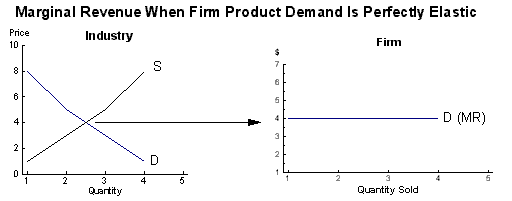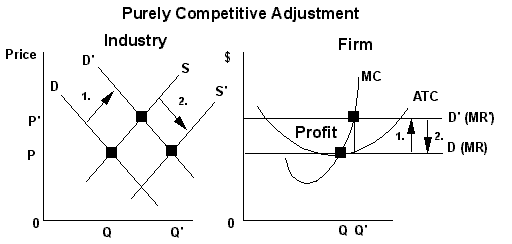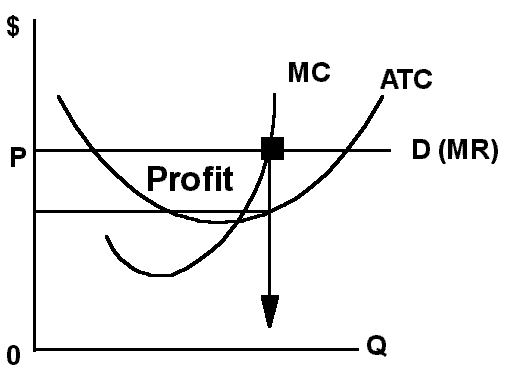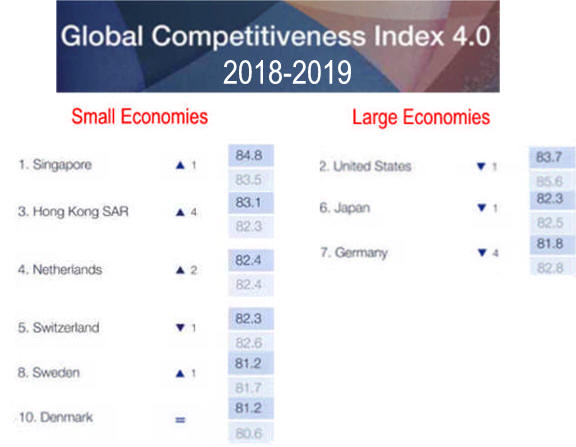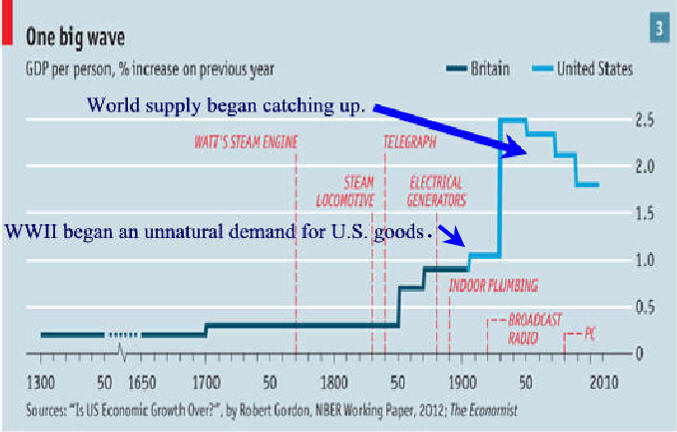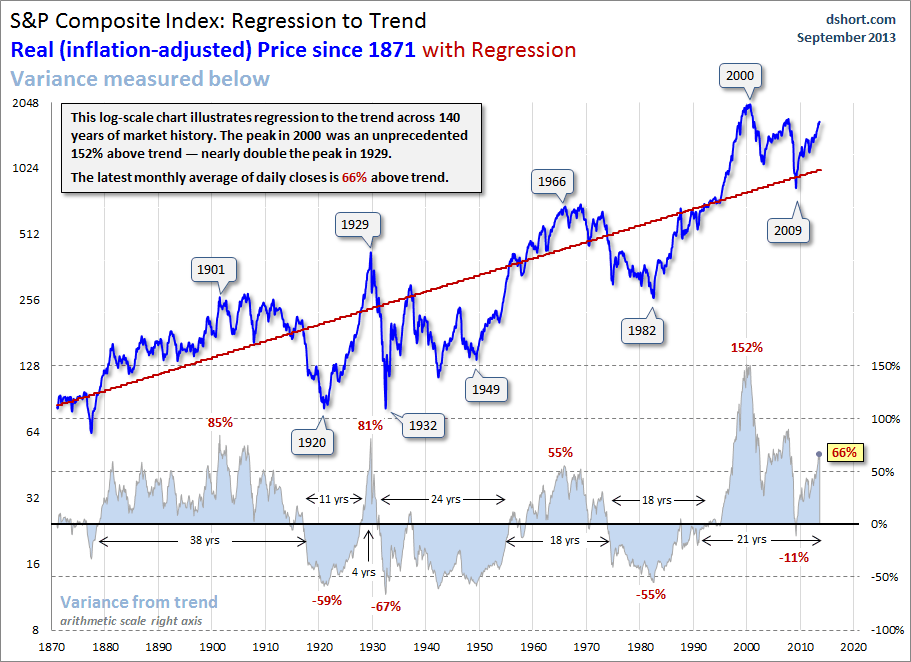III. Economic Analysis of Pure Competition
A. Competition is
efficient.
1.
Price settles where long-run ATC is at its lowest point indicating goods are
produced efficiently.
2.
P = MR = MC indicating that resources are allocated efficiently as
$'s spent by consumers (P) = the
$'s received by producers (MR) = the
$ cost of producers (MC) and
economic profit is zero.
B. Shortcomings
1.
Spillover costs (pollution) and benefits (education) aren't properly measured
resulting in
goods being over and
under produced.
a. Government intervention was needed to lower automobile pollution.
b. Governments supports education with grants and inexpensive loan problems
to students and colleges.
2.
Monopoly power develops to negate Adam Smith's "invisible hand" of
competition which is required to
assure that the purely
competitive adjustment occurs.
3. Eliminating economic
profit makes it difficult for competitive firms to afford expensive R & D technology.
4.
Economic Growth Volatility |
Application
Question
Is Purely Competitive Adjustment Causing a New Normal Or
Is
The New Normal Not New or Normal?
Beginning with economic expansion caused by WWII, demand for U.S.
manufactured goods increased dramatically. As a result, demand
increase from D to D.' Profits maximization resulted. Thanks in part to
Unions, these manufactures shared their excess profits with unionized
workers and wages increases spilled over to many nonunion workers. It took
Germany, England and Japan many years to repair war damaged manufacturers
and bring an end to U.S. manufacturer's monopoly power.
Serious competition from
foreign manufacturers beginning with automobiles and steel increased
supply causing Rust Belt Industries to lose their pricing power. This eliminated
excess profits. Some industries incurred a loss as supply increased too much.
Wage give backs began and many workers found themselves with stagnating wages.
Companies used technology and outsourcing to be more competitive and maintain
profit but this put pressure on wages.
This also happened in
the finance industry with competition coming from foreign banking and cheap
Internet trading. Their attempt to increase D for their services with exotic
products like derivatives has not worked out well as of 07/01/10.
The bottom line is the
standard of living enjoyed by U.S. citizens, their micro-lives, will grow more
slowly as it is forced to share the wealth with people from around the world.
We may even have to give some back because of our energy dependence and
recent decadence though increased production of energy with shale has lessened
lessen this dependency. But we will still enjoy the highest standard of
living in the industrialized world. |
IV. Competitive Supply
A. The firm's MC curve is its short-run supply curve.
B. Industry supply is the horizontal summation of the firm's supply
curves.
C.
Economics: Long
Run Supply - Cliffs Notes
analyzes the affect of long term supply on efficiency.
Unit V Review
requires many independent resource suppliers competing with virtually
identical factors
V. Other theories of the
Competitive Model
(from Wiki requires calculus)
A.
Bertrand competition
B.
Cournot competition
requires calculus.
VI. U.S.
Competitiveness Declines
Econintersect: The U.S. slipped
to seventh place in the ranking of economic competitiveness in the 2012.
source the WEF (World Economic Forum).
Last year the U.S. ranked fifth.
The current result marked the fourth year
of decline for the country that used to rule the competitiveness roost.
More
from econintersect.com.
IMD Disagrees with its 2012 World Competitiveness Rankings
Editor's comment
on free trade
Free trade increase supply
which forces price down resulting in
some combination of lower profit
or lower cost.
Owners and managers&inspire good at maintaining profit and will try to lower the cost of
materials,
labor or overhead. Workers often bear the brunt of this
process.
The effect of Covid on
Globalization is dramatically changing trade
|
Question Is Recovery from the Great
Recession indicating
A Few US Company Still Dominate,
Many Do Not
Technology will continue to make
our macro-lives better,
especially now that the Asians are contributing with
their
R&D investments and collaborative competition in science
helped by the
Internet has accelerate scientific advancement.
Plus gains from science
are often cumulative and while not a
straight line upward they eventually make
our macro lives better.
Think childhood diseases being cured and smart phones.
Plus its always good remember the best things in life will continue
to be
free and having enough money is a function of demand,
not supply. 08/12/11
updated 8/24/15
See
Promises, promises (3 graphs)

|

See
US Economic Normality 1945-2015
page 2,
World Changed and Good Jobs Disappeared
20th Century U.S. Decade Ranking
VII. Readings
A. For a conservative view of competition
Read
Pure and Perfect"
Competition? from
Capitalism Magazine By What Standard?
Part 5 in a Series of articles on Capitalism, Free-competition,
Antitrust, and Microsoft,
By Richard M. Salsman
B. Present
Day Application of the Purely Competitive Adjustment
C.
Collaboration
Competition is the New Competition
|
Citizen Well-Being
is Important and Continually Grows.
1) Our society's stability has
consistently increased US productivity
which is key to individual well-being. Think how the
public safety net
has increased since the 1930's and the success of the
federal
children's bureau. Think
economic distress in Russia, Europe,
and even Japan.
2) Scientific achievements have
continuously added to citizen
well-being. Think
public health, smart phones with loads of
free stuff not part of GDP or wages, streaming audio-
video, Gillette Stadium ... See
Health Problems Solved
3) Personal Income which is a function of nature and
Think nurture has
increased continuously if not always rapidly.
Russia, China,
and Europe's really slow recovery from the Great
Recession.
Source
Economic Wellbeing
Some Successful
Companies Pay Everyone Well

from
economist.com 01/12/1 and 10/1/16 |

